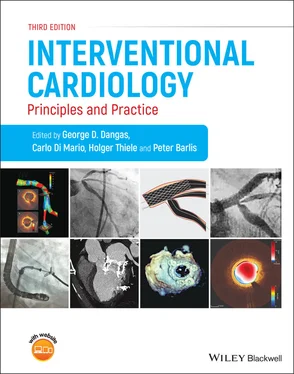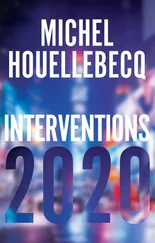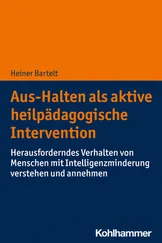Interventional Cardiology
Здесь есть возможность читать онлайн «Interventional Cardiology» — ознакомительный отрывок электронной книги совершенно бесплатно, а после прочтения отрывка купить полную версию. В некоторых случаях можно слушать аудио, скачать через торрент в формате fb2 и присутствует краткое содержание. Жанр: unrecognised, на английском языке. Описание произведения, (предисловие) а так же отзывы посетителей доступны на портале библиотеки ЛибКат.
- Название:Interventional Cardiology
- Автор:
- Жанр:
- Год:неизвестен
- ISBN:нет данных
- Рейтинг книги:4 / 5. Голосов: 1
-
Избранное:Добавить в избранное
- Отзывы:
-
Ваша оценка:
- 80
- 1
- 2
- 3
- 4
- 5
Interventional Cardiology: краткое содержание, описание и аннотация
Предлагаем к чтению аннотацию, описание, краткое содержание или предисловие (зависит от того, что написал сам автор книги «Interventional Cardiology»). Если вы не нашли необходимую информацию о книге — напишите в комментариях, мы постараемся отыскать её.
Interventional Cardiology
Interventional Cardiology
Interventional Cardiology — читать онлайн ознакомительный отрывок
Ниже представлен текст книги, разбитый по страницам. Система сохранения места последней прочитанной страницы, позволяет с удобством читать онлайн бесплатно книгу «Interventional Cardiology», без необходимости каждый раз заново искать на чём Вы остановились. Поставьте закладку, и сможете в любой момент перейти на страницу, на которой закончили чтение.
Интервал:
Закладка:
2 Chapter 2 Figure 2.1 Femoral artery angiogram taken after sheath insertion. The sheath... Figure 2.2 Bilateral femoral artery angiograms. On the left panel, a line is... Figure 2.3 (a) shows a fluoroscopic image recorded prior to puncture. The 18... Figure 2.4 (A) The ultrasound probe is aligned perpendicular to the artery (... Figure 2.5 The Perclose ProGlide device is used to deliver sutures through t... Figure 2.6 The StarClose device is delivered through a special sheath provid... Figure 2.7 Femoral angiogram 1 year after closure with the StarClose device.... Figure 2.8 MANTA device. A bovine collage pad in grey seals the arteriotomy ... Figure 2.9 Left panel: The white arrow shows the tip of a left internal mamm... Figure 2.10 Following the completion of the procedure, crossover angiography...
3 Chapter 3 Figure 3.1 Anatomic variations present challenges to successful transradial ... Figure 3.2 Navigating challenging radial anatomy using “balloon assisted tra... Figure 3.3 Complications of Transradial Access. (a) Radial perforation cause... Figure 3.4 Transradial hematoma classification system (From Bertrand et al .,... Figure 3.5 Distal radial access set up and hemostasis. (a) Hand into Starboa...
4 Chapter 4 Figure 4.1 Guiding catheter selection for left coronary artery. (a) Normal: ... Figure 4.2 Guiding catheter selection for right coronary artery. (a) Normal:... Figure 4.3 Ikari catheters for radial approach. (a) Ikari left. (b) Ikari ri... Figure 4.4 Optimal angiographic views for specific segments of the left ante... Figure 4.5 Guiding catheter selection for SVG to right coronary artery: (a1)... Figure 4.6 This 80‐year‐old obese female was admitted for angiography follow... Figure 4.7 These views were taken during primary angioplasty performed in a ... Figure 4.8 Optimal angiographic views for specific segments in the circumfle... Figure 4.9 This 47‐year‐old male with known coronary disease presented with ...
5 Chapter 5 Figure 5.1 Shapes of a selection of guide catheters for the left coronary sy... Figure 5.2 Shapes of commonly used guide catheters for the right coronary sy... Figure 5.3 The Barbeau and radial/brachial curve catheters can be used via t... Figure 5.4 Vascular anatomy of a pedicle graft of the right gastroepiploic a... Figure 5.5 Approaches to increase guide catheter support for treating comple... Figure 5.6 “Intraluminal” hybrid support techniques that can be used to subs... Figure 5.7 Components of guidewire design. Figure 5.8 The components of a rapid exchange balloon catheter. Figure 5.9 Distal tip styles and components contributing to the crossing pro... Figure 5.10 The primary curve is shaped to fit the tightest angle to be wire...
6 Chapter 6 Figure 6.1 Interpreting p‐values. Figure 6.2 Kaplan–Meier life‐table plot showing pattern of treatment differe... Figure 6.3 Example of the most common trial type, including superiority and ... Figure 6.4 Graphic explanation of the results from the SURTAVI trial, report...
7 Chapter 7 Figure 7.1 Behavior of resting and hyperemic flow in relation to stenosis se... Figure 7.2 The flow of blood across a coronary stenosis. Pressure gradients ... Figure 7.3 The curvilinear relationship between pressure and flow is unique ... Figure 7.4 Results of FAME and FAME II Studies. FAME randomized patients wit... Figure 7.5 Active and Phasic Normalization. (a) The pressure wire sensor sho... Figure 7.6 iFR Pullback can be used to predict post‐PCI iFR values. (a) The ... Figure 7.7 Right coronary artery assessment with iFR pullback and SyncVision... Figure 7.8 Left anterior descending artery iFR pullback and SyncVision Co‐Re... Figure 7.9 Examples of cases in which low FFR values are generated by high m... Figure 7.10 IMR calculation. A combined pressure/temperature guide wire is u...
8 Chapter 8 Figure 8.1 Four examples of artifacts from Gary Mintz’s Atlas of Intracorona... Figure 8.2 Normal coronary artery morphology in cross‐sectional view. In the... Figure 8.3 IVUS measurements pre‐intervention in a non‐stented artery. The p... Figure 8.4 A pure soft or hypoechoic plaque is uncommon because atherosclero... Figure 8.5 Diagnostic intravascular ultrasound was performed to assess the a... Figure 8.6 This patient presented with a STEMI a complex left anterior (lesi... Figure 8.7 An eccentric, calcific, and small plaque accumulation leading to ... Figure 8.8 Diagnostic IVUS was performed to assess this angiographic filling... Figure 8.9 This patient underwent a previous PCI with DES implantation of a ... Figure 8.10 This young, female patient presented with STEMI and type 4 SCAD ... Figure 8.11 This patient presented with restenosis at follow‐up after stent ...
9 Chapter 9 Figure 9.1 Frequent artifacts in optical coherence tomography imaging. (a) S... Figure 9.2 Plaque characterization with optical coherence tomography. (a) No... Figure 9.3 Plaque classification algorithm by optical coherence tomography (... Figure 9.4 Optical coherence tomography in coronary interventions. (a) Strut... Figure 9.5a Baseline angiogram of the the right coronary system shown on the... Figure 9.5b OCT following stent implantation with stent rendering on the lon... Figure 9.5c Final angiogram of the RCA following PCI is shown in the left im... Figure 9.6a OCT cross‐section demonstrates a protruding nodule with an MLA o... Figure 9.6b OCT of the proximal LAD revealed a lesion with an MLA of 3.55mm 2 Figure 9.6c OCT proximal to the bifurcation demonstrates a calcified lesion ... Figure 9.6d OCT at the bifurcation of the LAD and 1 stdiagonal branch. It is... Figure 9.6e OCT following stent implantation demonstrating optimal stent exp... Figure 9.7 A 39‐year‐old man was admitted with unstable angina. Angiography ... Figure 9.8 Angiography at baseline without significant stenosis (a). Angiogr... Figure 9.9 Intravascular near‐infrared fluorescence molecular imaging of pla...
10 Chapter 10 Figure 10.1 (a) Severe stenosis in the proximal RCA on CTA with high‐risk CT... Figure 10.2 (a) Post‐TAVR, a bioprosthetic valve is seen in aortic position,... Figure 10.3 (a) Early and (b) delayed contrast‐enhanced images of the left a... Figure 10.4 (a) and (c) diffuse LGE in the ventricles and atria. Classic fin... Figure 10.5 (a) Sinus venosus ASD with the right upper pulmonary vein draini...
11 Chapter 11 Figure 11.1 Suggested stepwise strategy for long term anti‐ischemic drug the... Figure 11.2 Approach for the initial diagnostic management of patients with ... Figure 11.3 Main diagnostic pathways in symptomatic patients with suspected ...
12 Chapter 12 Figure 12.1 Advantages and disadvantages or high sensitivity cardiac troponi... Figure 12.2 Algorithm for managing NSTE‐ACS patients and determining the tim... Figure 12.3 American and European guidelines on optimal DAPT duration in ACS...
13 Chapter 15Figure 15.1 Challenging angiographic assessment of disease severity. On the ...Figure 15.2 Provisional versus two‐stent technique. On the top (a) (RAO 20‐C...
14 Chapter 16Figure 16.1 Coronary bifurcation anatomy, flow characteristics and plaque di...Figure 16.2 Example of provisional strategy for distal left main stem trifur...Figure 16.3 Stepwise provisional SB stenting strategy. Panel (a) MV stenting...Figure 16.4 Proximal optimization technique. Panel (a) Large middle image – ...Figure 16.5 Two stent techniques. Panel (a) T stenting technique, Panel (b) ...
15 Chapter 17Figure 17.1 Heart Team decision‐making process in patients with multivessel ...
16 Chapter 18Figure 18.1 The basic features of a chronic total coronary occlusion (a and ...Figure 18.2 Bilateral contrast injection is essential for control of the wir...Figure 18.3 Proximal LAD occlusion with tapered entry (a). The tip shape for...Figure 18.4 Proximal RCA occlusion with two side branches (a). Perforation o...Figure 18.5 (a) Proximal RCA occlusion with a long intracoronary channel (sp...Figure 18.6 A proximal RCA occlusion with side branch and no visible entry (...Figure 18.7 Typical example of parallel wire approach: the first wire Gaia 2...Figure 18.8 Dual‐lumen catheter (DLC) application. Occlusion of the mid left...Figure 18.9 StingRay catheter application. Long occlusion of the left circum...Figure 18.10 The procedural steps of a retrograde approach. A proximal RCA o...
Читать дальшеИнтервал:
Закладка:
Похожие книги на «Interventional Cardiology»
Представляем Вашему вниманию похожие книги на «Interventional Cardiology» списком для выбора. Мы отобрали схожую по названию и смыслу литературу в надежде предоставить читателям больше вариантов отыскать новые, интересные, ещё непрочитанные произведения.
Обсуждение, отзывы о книге «Interventional Cardiology» и просто собственные мнения читателей. Оставьте ваши комментарии, напишите, что Вы думаете о произведении, его смысле или главных героях. Укажите что конкретно понравилось, а что нет, и почему Вы так считаете.










